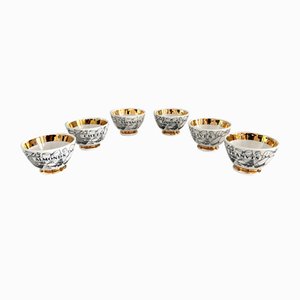Annalisa Rosso reviews the Fornasetti show at Milan's Triennale
The Legendary Fornasetti
-
Dining Chairs by Piero Fornasetti, Italy, 1990s
Photo © Versus Gallery
-
Sun Floor Lamp by Piero Fornasetti for Antonangeli, 1990s
Photo © Maden di Marta Leo
-
Palladiana Coffee Set, Piero Fornasetti for Rosenthal
Photo © Past Perfect
-
Basket by Piero Fornasetti for Atelier Fornasetti, 1950s
Photo © Antichità Brighenti Fausto
-
Porcelain Plate by Piero Fornasetti
Photo © GOLDwood
-
Capitello Chair by Atelier Fornasetti
Photo © GOLDwood
-
Tray with Fruit Motif by Piero Fornasetti for Fornasetti, 1960s
Photo © ETOZ GmbH
-
Il Giardino all'Italiana Carpet by Piero Fornasetti, 1980
Photo © Italo 900
-
Large Sole Ricciuto Plate by Piero Fornasetti, 1950s
Photo © Modernariato
-
Cards Box by Piero Fornasetti, Italy, 1980s
Photo © Maden di Marta Leo
-
Crystal Paperweight Sphere by Piero Fornasetti, Italy, 1970s
Photo © Maden di Marta Leo
-
Cigar Box by Piero Fornasetti for Atelier Fornasetti, 1960s
Photo © Carrozzeria900
-
20th Century Trinket Box by Piero Fornasetti, Italy, 1970s
Photo © Pushkin Antiques
Quotations from and about the late, great Piero Fornasetti pepper the exhibition 100 Years of Practical Madness, the most comprehensive retrospective of his impressive oeuvre to date, currently on view at the Triennale Design Museum in Milan. One of my favorites comes from design maestro Ettore Sottsass: “It is as if Fornasetti repainted all the existing world… everything seems so beautiful, so smooth, so magic, and mysterious, as you might imagine the infinite depths of the cosmos to be.” Although Fornasetti’s work existed primarily as interventions upon the surfaces of objects and spaces, his vision penetrated into our collective unconscious. It’s about time this complex and controversial Italian figure received a grand institutional treatment.
Curated by Fornasetti’s son Barnaba in celebration of the centenary of his birth, the show has a flavor of reconciliation. Milanese-born Fornasetti, who died over 25 years ago, likened himself to a Renaissance man; a moniker justified by his prolific output and diverse talents, working interchangeably as a painter, illustrator, engraver, craftsman, and decorator. Despite his popularity, particularly in the U.S. and U.K., and especially during the postwar years, the Triennale and other delegates of the international design establishment long marginalized his work.
For most of his lifetime, rationalist modernism dominated the cultural discourse, and nearly every form of decoration became an act of kitsch or defiance. Fornasetti remained undaunted by this party line, however, creating more than 11,000 designs across a spectrum of products, one-offs, furniture, and interiors. In terms of sheer volume, Fornasetti's production is one of the most significant of the 20th century.
The exhibition tries to capture the breadth of Fornasetti’s creativity through more than 1,000 objects drawn from the family archive: paintings from his early career; sketches and studies; furniture and clothing; reconstructed interiors; and a wealth of his most iconic plates, ashtrays, screens, foulards, and trays. “It has been hard to restrain, and choose what not to bring,” explains Barnaba, who successfully carried on his father’s work after his passing.
Among the most fascinating rooms is one dedicated to 100 trays, each displaying a unique and intricate design, or perhaps the corridor of self-portraits that demonstrate his deft draftsmanship. Of course, the signature Themes & Variations series is well covered. Dedicated to the beautiful face of opera singer Lina Cavalieri, which Fornasetti first encountered in an old newspaper, this motif became a sort of Fornasetti alter ego that adorned over 350 different objects. The ambiguous female gaze draws the spectators into a kaleidoscope of adaptations, nine of which are signed by Barnaba, including one in which the classic visage has a pierced tongue.
During the exhibition's opening, Fornasetti’s many friends and collaborators shared fond memories of the old shop in Via Brera, which always attracted a noteworthy crowd of creative talents and collectors. Fornasetti’s social circle aside, it seems that all Italians—myself included—have affection for Fornasetti’s work, even if they don’t know his name or the story behind it. He was a genius of unrestrained, fantastic invention, as well as a rigorous technician, and his novel imagery has been sewn into the cultural fabric of the nation. The exhibition’s organizers are currently investigating the possibility to travel the show internationally. Fingers crossed…
-
Text by
-
Annalisa Rosso
Annalisa is a freelance journalist, trendsetter, and independent curator often hired as an Italian correspondent on design and contemporary art. She is curious about everything, always looking for something new. Because unrest is a good engine.
-
More to Love
Italian Sun Floor Lamp by Atelier Fornasetti for Antonangeli Illuminazioni, 1990s

Small Vintage Dish by Piero Fornasetti

Ice Bucket by Atelier Fornasetti, 1950s

Advertising Plate by Piero Fornasetti for Armando Testa Studio, 1960s

Emporers Plates by Atelier Fornasetti, 1940s, Set of 4

Vintage Paper Basket by Piero Fornasetti for Atelier Fornasetti, 1950s

Mug with Lid and Saucer by Atelier Fornasetti for Fornasetti, 1990s, Set of 3

Appetizer Tray by Piero Fornasetti, 1960s

Saint Matthew Ceramic Plate by Fornasetti, 1970s

Table Lamp by Piero Fornetti for Atelier Fornasetti, 1970s

Ceramic Card Holder and Pocket Emptier by Piero Fornasetti for Fornasetti, 1950s, Set of 2

Decorated Metal Box by Piero Fornasetti, 1950s

Vintage Box by Piero Fornasetti, 1950s

Fornasetti Tray by Atelier Fornasetti, 1990s

Appetizers Bowls by Piero Fornasetti Fornasetti Milano for Atelier Fornasetti, Set of 6

Tray with Fruit Motif by Piero Fornasetti for Fornasetti, 1960s

Plate from the Astrolabe Series by Piero Fornasetti, Fornasetti Milan, 1971















 Photo © Antichità Brighenti Fausto
Photo © Antichità Brighenti Fausto
